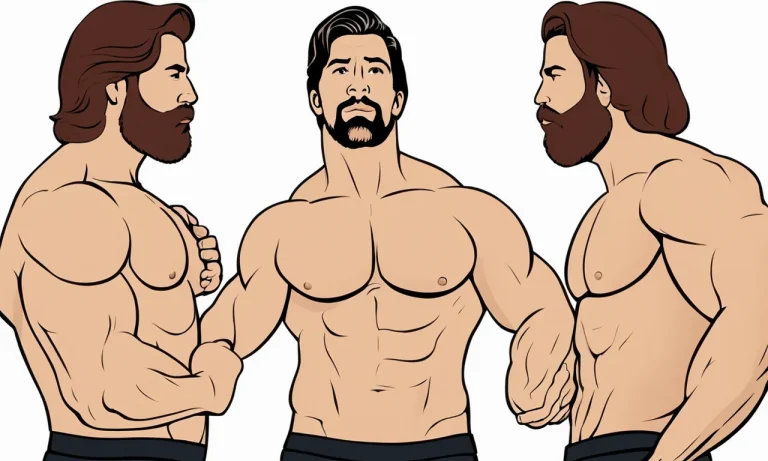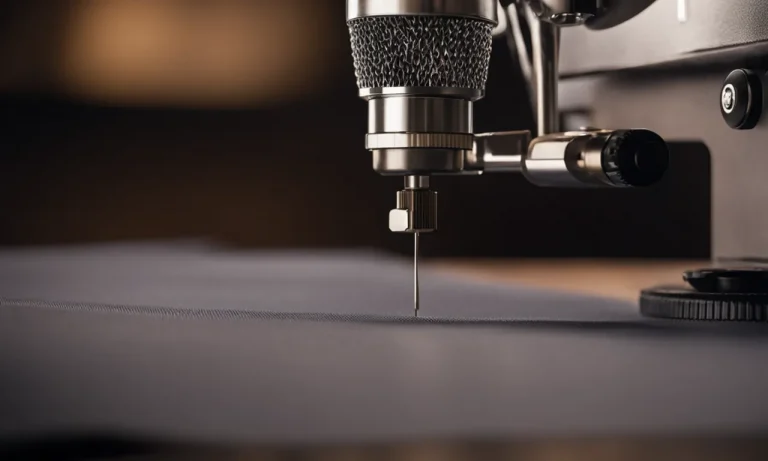How To Loosen An Elastic Waistband Without Sewing
If you’ve ever had a pair of pants or a skirt with an elastic waistband that has become too tight, you know how uncomfortable that can be. Luckily, there are several easy ways to loosen the elastic without having to break out the needle and thread.
If you’re short on time, here’s a quick answer to your question: You can loosen an elastic waistband by stretching it with your hands over time, weighting it down to stretch it out, ironing over the elastic on a low setting, or running it through the dryer on high heat to break down the fibers.
In this comprehensive guide, we’ll discuss why elastic waistbands can become too tight and the best methods for stretching them back out again using things you already have at home. We’ll also provide some extra tips for preventing your elastic waistbands from becoming too snug in the future.
Understanding Why Elastic Waistbands Shrink
Elastic waistbands are a popular choice for comfortable and versatile clothing. They provide flexibility and ease of movement, making them a favorite among people of all ages. However, over time, elastic waistbands may shrink and become tighter, causing discomfort and frustration.
Understanding why this happens can help you find the best solutions to loosen your waistband without having to sew.
The Science Behind Elastic
Elastic is a stretchable material that allows clothing to fit snugly around the body while still providing flexibility. It is made up of a combination of polymers, such as rubber or spandex, that have the ability to stretch and return to their original shape.
When elastic is sewn into a waistband, it is usually stretched to fit the desired size. However, repeated wear and washing can cause the elastic fibers to lose their elasticity and shrink.
How Heat and Moisture Impact Elastic
Heat and moisture can have a significant impact on the elasticity of an elastic waistband. High temperatures, such as those encountered during machine drying or ironing, can cause the elastic fibers to contract and become shorter.
Additionally, excessive moisture, whether from sweating or washing, can weaken the elastic fibers and cause them to lose their stretchiness. Therefore, it is important to take proper care of your elastic waistband garments by avoiding high heat and excessive moisture.
Why Body Changes Affect Waistband Tightness
Another factor that can contribute to a shrinking elastic waistband is changes in body size or shape. Our bodies naturally fluctuate in size over time due to factors such as weight gain or loss, pregnancy, or even normal aging.
As our waistlines change, the elastic in our waistbands may become tighter or looser. This is especially true if the elastic was stretched to its maximum capacity during the initial fitting. Therefore, it is important to consider these body changes when choosing clothing with elastic waistbands and to find ways to adjust the waistband to accommodate these changes.
Stretching the Waistband with Your Hands
Focus on Areas that Feel Too Tight
If you find that your elastic waistband feels too tight in certain areas, there are ways to address this without sewing. One method is to use your hands to stretch the waistband in specific areas. Gently pull and stretch the fabric in the areas that feel tight, such as around the hips or waist. By focusing on these specific areas, you can gradually loosen the elastic and improve the fit of your clothing.
Stretch Slowly and Gently
When stretching the waistband, it’s important to do so slowly and gently to avoid damaging the fabric or elastic. Apply light pressure and gradually increase the stretch as you go. This will help prevent any sudden tears or breaks in the elastic.
If the waistband feels resistant to stretching, try applying a little bit of water or a fabric softener to make the material more pliable.
Repeat Stretching Periodically
Stretching the waistband once may provide some temporary relief, but it’s important to note that elastic can gradually return to its original shape over time. To maintain a looser fit, repeat the stretching process periodically.
This will help ensure that the waistband remains comfortable and accommodating for your body shape.
Remember, these methods are meant to provide a temporary solution for a tight waistband. If you find that the waistband consistently feels too tight, it may be best to consider altering or replacing the elastic.
Weighing Down the Waistband
When it comes to loosening an elastic waistband without sewing, there are a few simple tricks you can try. One effective method is to weigh down the waistband with heavy objects.
Place Heavy Objects Inside the Waistband
A great way to loosen the waistband is to place heavy objects, such as books or weights, inside the waistband. This extra weight will stretch out the elastic and help it to expand. Make sure to evenly distribute the weight throughout the waistband for the best results.
It’s important to note that you should only use objects that won’t cause any damage or discomfort when wearing the garment. Avoid sharp or bulky items that may poke or irritate your skin.
Leave Overnight for Best Results
For optimal results, leave the heavy objects inside the waistband overnight. This will give the elastic ample time to stretch and conform to the desired size. In the morning, remove the objects and try on the garment to see if the waistband has loosened to your liking.
If the waistband is still too tight, you can repeat the process for another night until you achieve the desired fit. Remember to be patient and give the elastic enough time to adjust.
This Also Works for Cuffs and Sleeves
Not only can this method be used to loosen elastic waistbands, but it can also work for cuffs and sleeves. If you have a garment with tight cuffs or sleeves, simply place the heavy objects inside and leave overnight. This will help to stretch out the elastic and make it more comfortable to wear.
Keep in mind that this method may not work for all types of elastic, particularly if it is old or worn out. In such cases, it may be necessary to replace the elastic or seek professional alterations.
Remember, these methods are temporary fixes and may not provide a permanent solution. It’s always best to consult with a tailor or seamstress for more permanent alterations to your clothing.
Using Heat to Loosen the Elastic
If you find yourself with a tight elastic waistband on your favorite pair of pants or skirt, there are several methods you can try to loosen it without sewing. One effective technique involves using heat to relax the elastic fibers, making the waistband more comfortable to wear.
Here are a few methods you can try:
Ironing on a Low Setting
One way to loosen an elastic waistband is by ironing it on a low setting. Start by turning your garment inside out to protect the fabric. Place a thin cloth or pressing cloth over the waistband to prevent direct contact with the iron.
Gently press the iron over the waistband, moving it in a back-and-forth motion. Be careful not to apply too much heat or press too hard, as this could damage the fabric. Allow the garment to cool before trying it on again. This method can help relax the elastic and provide a bit of extra stretch.
Tumbling on High Heat in the Dryer
Another option is to tumble your garment on high heat in the dryer. Start by turning your garment inside out and placing it in the dryer. Add a few clean, dry towels to the load to help absorb moisture and provide bulk. Set the dryer to a high heat setting and let it run for about 10-15 minutes.
The heat and movement of the dryer can help relax the elastic fibers, allowing the waistband to stretch more easily. Once the cycle is complete, take out your garment and try it on to see if the waistband feels looser.
Caution About Melting Synthetic Fabrics
While using heat can be an effective way to loosen an elastic waistband, it’s important to exercise caution, especially when dealing with synthetic fabrics. Some synthetic materials, such as polyester or nylon, can melt or warp under high heat.
Before attempting any heat-based method, check the care label on your garment to ensure it can withstand the heat. If you’re unsure, it’s best to err on the side of caution and choose a different method to avoid damaging your garment.
Remember, these methods may not work for all types of elastic waistbands or fabrics, so it’s always a good idea to test them on a small, inconspicuous area first. If you’re unsure or uncomfortable trying these methods on your own, it’s best to consult a professional tailor or seamstress who can provide expert advice and assistance.
Preventing Elastic Waistbands from Getting Too Tight
Wash in Cold Water and Line Dry
One of the best ways to prevent elastic waistbands from becoming too tight is to wash your clothes in cold water and line dry them. Hot water can cause the elastic to shrink, making the waistband tighter.
By washing your clothes in cold water, you can help preserve the elasticity of the waistband and prevent it from becoming too constricting.
Line drying your clothes also helps to maintain the elasticity of the waistband. The heat from the dryer can cause the elastic to lose its stretchiness over time. By air drying your clothes, you can avoid subjecting the waistband to excessive heat and help keep it in good condition.
Avoid Dryer Sheets and Fabric Softener
When caring for clothes with elastic waistbands, it’s important to avoid using dryer sheets and fabric softener. These products can leave a residue on the fabric, which can make the waistband less stretchy and more likely to become tight.
Dryer sheets and fabric softener can also cause a buildup of static electricity, which can lead to clothes sticking to your body and making the waistband feel tighter than it actually is. To keep your elastic waistbands in good shape, skip the dryer sheets and fabric softener.
Wear Waistband Expanders
If you find that your elastic waistbands are consistently feeling too tight, you can try using waistband expanders. These are small accessories that attach to the waistband and provide extra room and flexibility.
Waistband expanders come in various forms, such as elastic waistband extenders, button extenders, or hook extenders. They can be easily attached to your waistband to help alleviate any tightness and make your clothes more comfortable to wear.
By following these tips, you can prevent your elastic waistbands from getting too tight and ensure that your clothes fit comfortably. Remember to wash in cold water, line dry, avoid dryer sheets and fabric softener, and consider using waistband expanders when needed.
Conclusion
Elastic waistbands are designed to stretch and recover, but over time they can lose some of their stretchiness and become uncomfortably tight. Thankfully, there are many simple, no-sew tricks you can try at home to loosen a too-snug elastic waistband.
By gently stretching the waistband by hand, weighing it down to stretch it out, applying targeted heat from an iron or dryer, or being proactive about caring for the elastic fibers, you can comfortably let out your waistband a little without having to break out the sewing kit.
With the techniques discussed here, you’ll be able to loosen a pinch-y waistband in no time. Just be careful about applying heat and not over-stretching the fabric. With a little patience your pants or skirt will once again be comfy and wearable in no time!







